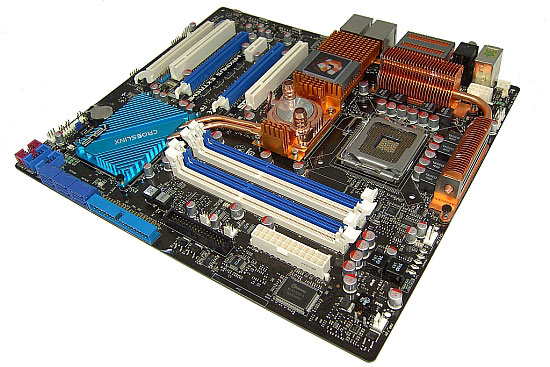ASUS Maximus Extreme - the Extreme Benchmarker's Choice?
by Rajinder Gill on December 10, 2007 8:00 AM EST- Posted in
- Motherboards
Introduction
Irrespective of cost versus performance ratios, even the smallest gains are more than enough to convince the enthusiastic front line benchmarkers and PC enthusiasts that DDR3 based motherboards are a justified purchase. However, finding the right motherboard to fill the role of extreme benchmarking can be a challenge to say the least. Out of the box, nearly all motherboards that fall into the mid/low-end of the market are unsuitable for extreme benchmarking - unless the user applies voltage modifications to them. Let's not forget the risks of voltage modifications; often users push the components used on the budget-oriented offerings far past their specifications, which seriously reduces component life spans. In addition to this, most moderately priced motherboards lack or do not provide full control over some of the chipset registers that are needed to fine tune system stability/performance at break-neck Front Side Bus (FSB) and CPU speeds.
 |
Using sub-zero cooling methods can enable most Intel 65nm processors to scale well past 4GHz (chilled water/phase cooling), and even 5GHz using liquid Nitrogen. Even though processor cooling does make up a large part of the overclocking equation, there's more than just low operating temperature and high voltage requirements to guarantee success. The board must have stable and clean voltage delivery circuits for the CPU, Northbridge, and memory. The motherboard PCB should be at least a six layer design (with excellent trace routing) to minimize signal inductance and crosstalk. Selection of high quality transistors, resistors, and capacitors can also be critical; low tolerance, low drift, and low noise components are required to ensure accurate and stable power delivery under heavy load conditions.
Lastly, optimized board layouts and onboard device cooling options are needed, to satisfy both extreme benchmarkers and gaming enthusiasts simultaneously (this is another challenge). Manufacturers cannot afford to base a motherboard around extreme users alone. Yes, this segment is a growing industry, but the number of sales generated by this niche group will never cover the invested time/R&D for manufacturing the product. Whichever way we look at the options, there has to be component and board layout compromises to meet several different market opportunities.
ASUS caters to this upper-end niche market with its ROG (Republic Of Gamers) product line. As the ROG motherboard line has evolved, ASUS has tried to satisfy the extreme users and gaming enthusiasts alike with excellent board layouts, stable operation across a wide variety of conditions, and unlocking additional BIOS tweaking functions not found on their other motherboards. The ROG boards that bear the 'Extreme' suffix after their name are generally the ones that ASUS provides with the best components and widest range of voltage and BIOS options. The Maximus Extreme we are reviewing today shares many of the engineering principles employed on the Maximus Formula that we tested last month. The most obvious difference between the two boards is that the Extreme version features DDR3 support, as opposed to DDR2 on the Maximus Formula. We expect that overall FSB limits on both boards will be similar due to the same overall circuit topologies employed in most key areas of the board.
With that said, DDR3 support opens up the possibility of increased benchmarking scores. As such, we expect users who buy this product will want to push the board hard, so not only will we provide a subset of the standard AnandTech benchmark suite, but also some extreme cooling results to see where this board fits in to ASUS' diverse product line. Now, let's move on to the fun….










27 Comments
View All Comments
retrospooty - Monday, December 10, 2007 - link
Wireless works yes. They are linked up through the base and work in dos mode. Both RF, and bluetooth meese work.kilkennycat - Monday, December 10, 2007 - link
I notice from the board picture that the rear mounting holes are still in the corners of the board, so if the WIDTH is 4cm more than the standard ATX, does the board need special mounting ? I assume that WIDTH means the distance across the edge of the board in contact with the rear of the case. Please correct if my assumption is wrong.Rajinder Gill - Monday, December 10, 2007 - link
THe width is the length across the top edge of the board. Screw hole spacing is still standard ATX, just that this board over-hangs by a few cm (the Sata port end will protrude further into your case) ...regards
Raja
kilkennycat - Monday, December 10, 2007 - link
As yes, you actually mean DEPTH of course, if referencing tower case dimensions (Height x Width x Depth). So any case wishing to accommodate this board needs to have at least 4cm DEEPER front to rear clearance for the motherboard, nothing to do with it being a mid-tower or full-tower. Am I right?Might also preclude using this MB in those cases having the motherboard mounted on a slide-in ATX tray ( a great feature, btw ), as they may have a lip or other registration hardware on the leading-edge of the tray.
retrospooty - Monday, December 10, 2007 - link
What size are they? I cant find it here, or on Asus's site. They look like 1/4 inch - which kind of sucks.Rajinder Gill - Monday, December 10, 2007 - link
The fittings are 1/4", but ASUS does provide adapetrs to use 1/2 tubing..Raja..
retrospooty - Monday, December 10, 2007 - link
thanks... bummer. 1/4 restricts my flow.